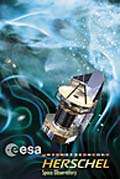Exploring space

(PhysOrg.com) -- One of the most powerful and ambitious astronomical satellites designed to provide the best view yet of the Universe at far-infrared and sub-millimeter wavelengths is living up to its illustrious name, according to Cardiff astronomers.
Cardiff astronomers have been heavily involved in using the Herschel Space Observatory, launched exactly two years ago (14th May), designed to observe the sky at infrared wavelengths and named after Sir William Herschel, a leading astronomer who discovered infrared light around two hundred years ago.
"Those of us working on the Herschel Space Observatory think it's very well named", said Professor Matt Griffin, School of Physics and Astronomy, and lead scientist of the SPIRE mission.
"It follows in the footsteps of William and Caroline Herschel in surveying the heavens, and it uses the planet that William Herschel discovered as a standard source. Not only that, our cameras on board the satellite actually use a basic technique used by William Herschel himself to measure the infrared light," he adds.
Born "Friedrich Wilhelm Herschel" in Germany in 1738, William moved to England aged 19, and became one of the leading astronomers of his time. In 1800, he discovered infrared light, which has wavelengths longer than visible light that we see.
Herschel was also a very accomplished telescope builder, and spent much of his time systematically observing the sky looking for double stars and nebulae. Working from his home in Bath in 1781, one of William’s most famous discoveries was the planet Uranus. He gained favour from King George III by trying to name it the "Georgian Star", though the name didn’t stick. The favour did, however, and he was appointed The King’s Astronomer in 1782. Besides making many astronomical discoveries, in 1800 William also discovered infrared radiation, which has wavelengths longer than that of visible light.
The Herschel family was a particularly astronomical one, with both his sister, Caroline, and son, John, playing important roles in the history of astronomy.
Today, the Herschel Space Observatory is still making use of the planet Uranus. The extensive study of our Sun’s seventh planet means that it is very well understood. Herschel’s SPIRE instrument regularly observes Uranus so that astronomers can calibrate other measurements against the well-known brightness of Uranus.
Uranus is too small for the Herschel satellite to see as more than a very bright point of light. In the background of the image are dozens of faint fuzzy blobs, each one a distant galaxy. This is an excellent illustration of Herschel’s power, as the faint galaxies are typically ten thousand times fainter than the much closer planet Uranus.
Caroline Herschel worked closely with William, and was one of the first female astronomers. She made many discoveries of her own, including a number of comets which bear her name.
When she was awarded a £50 annual stipend by King George III, Caroline became the first woman to have an official government appointment. After William's death in 1822, Caroline moved back to Germany and completed his catalogue of nebulae. In recognition of her astronomical work, she was the first woman to be awarded the Gold Medal by the Royal Astronomical Society. The Herschel catalogue of more than 2000 objects formed the basis of the astronomical catalogue which is still used today.
Comets have been important throughout history, and remain so today. They are icy snowballs which were formed at the same time as the planets nearly 5 billion years ago. Detailed studies of comets shed light on the Solar System early in its history, and provide hints as to how the Earth has changed since its formation. While the Herschel Space Observatory isn’t observing any of Caroline’s cometary discoveries, most of which whizzed past Earth and left the Solar System, it has observed a number of others.
Fittingly, the Herschel satellite observes in a very similar way to the technique used by William and Caroline Herschel themselves – it methodically and systematically scans the sky recording exactly what is seen over large areas of the heavens. It is the ends of these scans which give the jagged appearance to the Herschel images.
The family connection to the work of the Herschel satellite doesn’t end with Caroline.
William’s son, John, was also an astronomer, and added thousands more objects to the catalogue compiled by William and Caroline. He discovered that many of the bright stars in the sky are located in a band which is tilted up relative to the disc of stars that makes up most of our Galaxy. It was an American astronomer, Benjamin Gould, who established that there was a full ring around the sky. Now known as the Gould Belt, it contains most of the nearby star forming regions, such as the Orion Nebula, and it provides us with a panoramic view of how stars like the Sun are still forming in the Milky Way today.
The far-infrared light measured by the Herschel Space Observatory makes it the ideal instrument for studying star formation, and the Gould Belt is one of its main targets. Using Herschel, Astronomers have mapped star formation in many areas of the Gould Belt, from the Southern Cross to Cygnus, the Swan.
Professor Derek Ward-Thompson, School of Physics and Astronomy, said: "Herschel is doing an excellent job of studying star formation in our Galaxy. Two years after launch it is truly fulfilling its potential."
Professor Matt Griffin added: "Two centuries on, I think William and Caroline would be intrigued and certainly quite pleased to see how what they started has developed."
Provided by Cardiff University



















